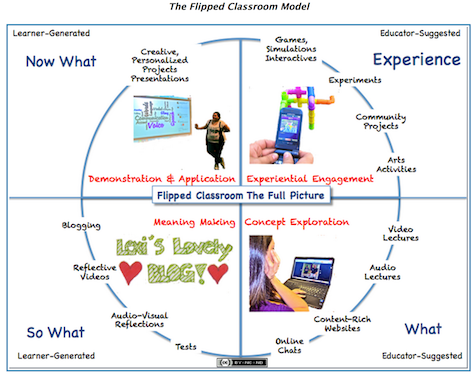Using the flipped classroom for professional development and continuing education represents an opportunity for organizations in the business of lifelong learning to deliver more value and create much greater impact. This article provides an overview and examples.
Other posts in this series:
- Leveraging MOOCs for Professional Development and Continuing Education
- Leveraging Microlearning for Professional Development and Continuing Education

Definition of Flipped Classroom
In a flipped classroom approach to learning, participants are assigned learning materials and tasks to engage with individually in advance of meeting in real time as a group. The goal is for this advanced preparation to foster more productive learning opportunities during live group sessions. Building off of shared foundational knowledge learners may, for example, be better prepared than in traditional classroom scenarios to actively discuss a topic or practice new concepts and skills. This higher level of engagement can, in turn, lead to much stronger and longer lasting learning outcomes.
Arguably, Salman Khan’s Khan Academy was the spark that lit the recent explosion in interest in flipped approaches to learning. To date, flipped learning has made more inroads into K-12 education than other sectors, but the approach clearly has value across all levels of education and learning.
Flipped Classroom for Professional Development: Readings
I recommend the following introductory resources for flipped learning and how a flipped classroom approach works.
- 7 Things You Should Know About Flipped Classrooms
I recommended an Educause “7 Things” article for background on MOOCs, and the one the organization published on flipped learning is equally valuable. If you read/view nothing else on this page before the session, please read this. - To Flip, or Not to Flip? Your Classroom, That Is.
This article from IACET draws links between the flipped classroom approach and adult learning principles. - Flipped Learning: What’s Its Place in the Association Meetings Space?
This article in the March 2015 edition of ASAE’s Associations Now considers how flipping might be applied to traditional association meetings. - Using Digital Media in new learning models (Flipped and Blended Learning)
An “infokit” from JISC Digital Media (a U.K. nonprofit) covering key aspects of flipped and blended learning
Flipped Classroom for Professional Development: Examples
I have found relatively few example so far of associations embracing flipped learning – or, at least, sharing any meaningful data from their experiences. One of the best documented examples is from the American Nurses Credentialing Center – the first item below – but access to the article on it costs $20. (Worth it, in my opinion.)
- Flipping the Classroom: A Data-Driven Model for Nursing Education
- Seven Steps to Flipped Professional Development (NASSP)
- Flipping Your Hairdresser’s Education – to Make You More Beautiful!
- Flipped Classroom 2.0: Competency Learning With Videos (K-12 example, but the mastery concept is useful for professional development)
While the following video (Nursing Education: How to Flip the Classroom) is a higher education example, it does a good job of walking through the details of an actual flipped learning experience. The same general principles and practices apply in most continuing education and professional development scenarios.
Flipped Classroom for Professional Development: Tech Tools
As with MOOCs, arguably, the tools used for flipping are not much different from the ones that have traditionally been used for e-learning or, for that matter, traditional classroom education. Videos, of course, get much of the focus in flipped classroom discussion. It’s worth remembering, though, that Salman Khan – arguably the father of flipped learning – used very cheap, simple tools to create the original 2,000+ videos for Khan Academy. Bottom line: don’t obsess about the technology. In my opinion, flipped learning is much more about how to take advantage of the new opportunities flipped learning creates in your live sessions.
That said, technology does certainly play a roll. I will likely come back and update this post with a list of specific tools, but for the time being, I’ll point you to a couple of good tool posts that already are out there:
Jeff
P.S. – Related posts:
- Leveraging MOOCs for Professional Development and Continuing Education
- Leveraging Microlearning for Professional Development and Continuing Education
And be sure to check out a great Leading Learning podcast episode on flipped learning: Serious Flipped Learning with Dr. Brian McGowan.
Sign up for the free Leading Learning newsletter and we’ll send you resources each month to help you stay on top of the latest trends and grow your education business. You’ll also get access to our comprehensive report Association Learning + Technology.

Leave a Reply